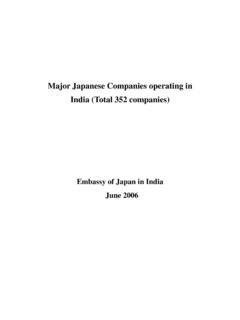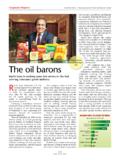Transcription of Cross Holding Strategy to Increase Control: Case of …
1 WORKING PAPER: 06-03 Mar. 2006 Cross Holding Strategy to Increase control : Case of the Tata Group by Ram Kumar Kakani & Tejas Joshi XLRI, Jamshedpur 831001, india E-Mail: XLRI Working Paper: 06-03 2 Cross Holding Strategy to Increase control : Case of the Tata Group1 Ram Kumar Kakani & Tejas Joshi E-Mail: Abstract Crossholdings is a common phenomenon across Asia. Within a business group, Cross - holdings amongst group affiliates are often used to fund a group s (unstated) empire building objectives. There has been a large amount of international empirical work focusing on the various aspects of crossholdings Strategy adopted by international business groups. In the Indian literature, we found little work, especially with respect to case studies. In this paper, we use public information of a well known business group (the Tatas) going through a decade long restructuring and we attempt to document their Cross holdings Strategy .
2 While the increased Cross holdings does benefit a business group through increased management control yet the findings hold enough water to conclude that these moves are contradictory to the interests of the minority shareholders in the individual operating companies ( , its own affiliates). Key Words: Business Group, Business House, Business Network, Cross Holding , Governance, Indian, Management control , Ownership Structure, Pyramidal Structure, and Shareholders. 1 The authors would like to express that the discussion and analysis mentioned herein is purely for academic purposes with no other intentions whatsoever. XLRI Working Paper: 06-03 3 Cross Holding Strategy to Increase control : Case of the Tata Group 1. Introduction A pleasant December evening breeze blew through the Jubilee Park of Jamshedpur2.
3 Reputed businessman, S. Bansal3 was on his usual evening walk, part of his life style for over four decades. S. Bansal, a retired Tata Steel employee had come to Steel City after graduating in Metallurgy from the illustrious Indian Institute of Technology (IIT) Kharagpur. Thus, began his life long stint with the Tata Group, and his affection for Steel city which made him take a decision to settle here. S. Bansal was a member of the old guard and had seen winds of change at the helm and across the group during his career. He had seen the successes, failures, achievements and controversies that had encircled the group for over half a century. During the walk, Bansal was chatting and the discussions spanned a array of topics ranging from politics to the Tata Group. Invariably, Bansal was a storehouse of insights into the Group, its culture, its philosophy and anecdotes of course.
4 But this December evening was slightly different, in the sense of the experiences Bansal was sharing. His voice had a serious and nostalgic undertone to it. He was sharing his perspective on the transition of the Tata Group; on what he felt was not the same about it as before. As the sun set past the horizon, Bansal smilingly said, The Tata Group has just started doing business Perhaps this statement had a deep rooted meaning that probably S. Bansal put forward in a very subtle manner. Did he mean that the group had started deviating from its corporate values and ethical standards for which it was respected for over a century? We had been reading news articles about the Tata Group changes for quite a few years now. There was definitely something more to it than met the eye. We decided to take this in more detail especially at the changes the group had undergone in the last We use the following path to discuss our case analysis based research work: In section 2, we briefly review the existing literature on crossholdings.
5 Section 3 gives an overview of the Tata group; it also describes the recent changes and the restructuring exercise under the new leadership. In Section 4, we present the empirical data and an analysis-cum-discussion of the findings. The data and information we use has been obtained from various websites of stock exchanges5, the Tata Groups website, CMIE-PROWESS package, and ISI Emerging Markets database. All these 2 Jamshedpur is a beautiful city in the eastern part of india , created by the Tata group. 3 Names have been changed to protect confidentiality. 4 Also an investigation on whether there was a lack of synchronization between what the Tata Group projected in the media as its high standards of corporate values and between their actions. 5 Websites of the National Stock Exchange ( ), the Mumbai Stock Exchange ( ), and the securities regulator, SEBI website ( ) XLRI Working Paper: 06-03 4databases have been used extensively by researchers in india and hence are highly reliable.
6 We end our paper in Section 5 with our conclusions and limitations of the study. 2. Literature Review Sinha (1998) argued that Cross holdings have economic significance and must be taken into account in both equity investment and lending situations. Cross holdings and the stability of relationships that result, probably allow Japanese and Korean companies to adopt a longer-term perspective in their decision making, than is possible in the US. They concluded by stating that Cross holdings Increase the debt bearing capacity of firms and should not be completely eliminated during credit analysis. Khanna and Palepu (2000) presented an empirical analysis of diversified Indian business groups in relation to corporate scope and institutional context. The performance of firms affiliated with diversified business groups with unaffiliated firms in the emerging economy of india is compared.
7 The authors interpret their findings to suggest that concentrated owners generally do not seem to affect performance positively, as evocative evidence that groups might have settled into quiet life equilibrium. Commenting on Japanese keiretsus, Tam (2001) stated that the new accounting standard puts a dent in corporate Cross holdings the glue Holding many of them together. It mentions how Cross holdings have traditionally provided companies with a base of stable shareholders; preventing takeovers and shielding management from shareholder pressure. This has contributed to Japanese companies low emphasis on dividends, shareholder meetings and investor relations in general along with less float in issues leading to illiquidity and price volatility. Companies are under pressure to revalue Cross holdings and sell off those Cross holdings whose stock prices have underperformed in order to improve their balance sheets.
8 Using a twelve year empirical study on 240 Indian business groups, Kakani (2002) found that diversified Indian conglomerates destroy shareholder value and have poor financial performance compared to the focused business groups. The work commented on the complex web of Cross holdings of diversified conglomerates and resulting lack of transparency being some of the reasons behind the results. Patel et. al. (2002) studied the relationships between Transparency & Disclosure scores and Cross - holdings for 19 emerging markets including india . For most of the countries including india , correlation between Cross - holdings and Transparency & Disclosure (T&D) score is negative, whereas correlation between price-to-book ratios and T&D scores is positive. This might imply that groups with complex Cross holdings are not as transparent in their dealings and so their stocks may be lower priced in the marketplace by the investor community as compared to those of independent firms.
9 Clark and Wojcik (2005) using German corporate data found a significant negative relationship between ownership concentration and the average daily rate of return (as measured by closing stock market prices). A reason mentioned in the paper for this was that the portfolio investors are concerned about the potential for exploitation that is, the likelihood that their place as minority XLRI Working Paper: 06-03 5shareholders and largely passive owners at that may be exploited by other better placed owners with greater access to private information. One can conclude the above literature discussion has an overwhelming support on the negative effects of Cross holdings . If we combine the above literature review with the statement made by S Bansal then it raises a storm of questions in ones mind.
10 Suspicions on the concurrency between the words and actions of the most revered business house in india need a very objective method of 3. The Tata Group The House of Tatas is one of the oldest business groups in india . Not many Indians would need an introduction to the House of Tatas. The group is largely operated through a Holding company, namely, Tata Sons. We provide a brief historical overview and then proceed with describing the recent restructuring exercise and other changes made. Established by Jamsetji Tata in the second half of the 19th century, the Group has grown into one of india 's biggest and most respected business organizations, largely due to the entrepreneur s vision, their commitment, and its fortitude in the face of adversity (Lala, 2004). Of the ventures that did bear fruit while Jamsetji was alive, the Taj Mahal Hotel in Bombay has to rank highest.






